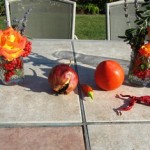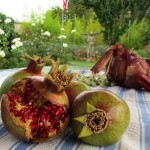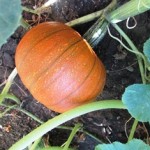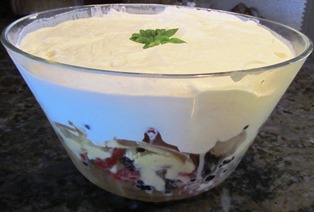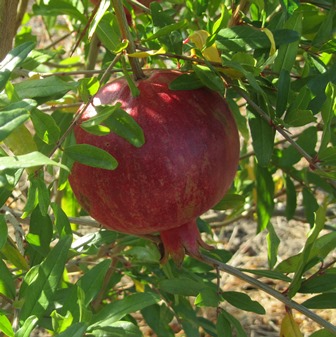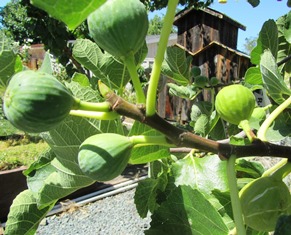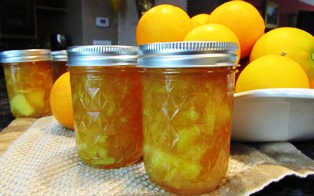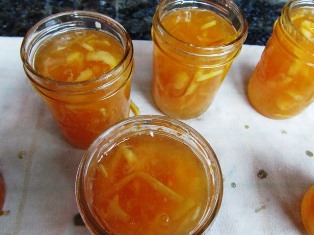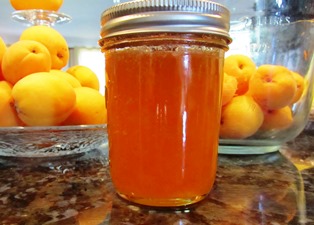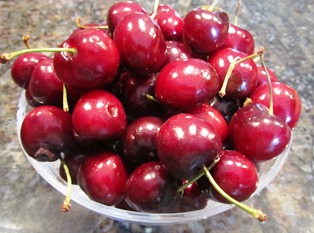Simple Gratitude for the Harvest
It’s nearly Thanksgiving and our Henny Penny Farmette continues to bring forth delicious, organically grown edibles for our table for which we feel truly grateful.
We give thanks, too, for neighbors like Dan and Annie. This past Sunday, Annie carted to our house a box of persimmons and bags of apples and pomegranates. We harvested all our apples last month so her timing was great. While we have persimmons and pomegranates hanging on the trees in our small orchard, many are not yet ripe enough to pick.
Last month, I froze cubes of butternut squash in freezer bags and readied pumpkin flesh for pie. While picking a few ripe persimmons recently, I noticed that we’re sharing them with a visitor who seems to sneak in and munch during the night. I’m thinking the culprit could be a raccoon, opossum, skunk, squirrel, fox, or a gaggle of wild turkeys that seem to make an annual pilgrimage through our area.
The two main types of persimmons grown on our farmette are Fuyu and Hachiya. The Fuyu is rather squat-looking and Hachiya has an elongated shape. Both take on a bright orange color in the fall. When fully ripe, Fuyu is sweet and crunchy like an apple whereas the Hachiya is soft like jelly. Though commonly thought of as fruits, persimmon and pomegranate are technically berries.
Fuyu persimmons can be peeled, sliced, and eaten fresh, roasted, or tossed into salads. They add a vibrant splash of orange to a winter salad that could include slices of citrus and pear tossed with greens,walnuts, pomegranate seeds, and goat cheese.
Pomegranates are ripe when their leathery outer covering turns red and begins to crack. Inside each pomegranate is white tissue separating compartments of ruby-red seeds called arils.
The seeds are high in antioxidants that reduce inflammation and free radical damage. Though they are messy to remove, the pomegranate seeds are healthy and nutritious additions to any diet.
To preserve pomegranate seeds, freeze them on a baking sheet. Once frozen, slip the seeds into freezer bags and return to the freezer. The seeds can be kept frozen for months.
Pumpkins come in a variety of sizes and types. Personally, I prefer the sugar pumpkins for recipes calling for pumpkin as an ingredient.
This week as we prepare for the big feasting day of Thanksgiving, lots of cooks are already baking pumpkin pies. Many will use canned pumpkin as a shortcut to their pie preparation but pumpkin filling made from scratch is especially delicious.
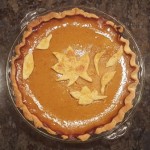
Our pumpkin pie features leaves of pie dough, brushed with egg, and sprinkled with sugar before baking
The old fashioned way to make pumpkin pie from scratch is to use fresh, organic pumpkin puree from the produce that you’ve grown in your garden. The process to make a pie takes longer because first the pumpkin must be peeled, seeded, and cut into manageable pieces and then cooked down. Then just follow your favorite pumpkin pie recipe.
_________________________________________________________________
Taking care of yourself is one of the most important things you can do over your lifetime and it starts with healthy ingredients and fresh produce.
My newest self-help wellness book is THE SELF-CARE PLANNER, A Weekly Guide to Prioritize You.
My books are available for purchase through online and traditional bookstores everywhere. Buy The Self-Care Planner and other titles offered by my publisher, Simon & Schuster online. Visit my author’s page at https://www.simonandschuster.com/authors/Meera-Lester/2137649823

It’s never too late to get healthy and live a richer, fuller, and more meaningful life. Self care is not selfish but rather an act of love.
YOU NEED THIS BOOK. WE ALL DO.
Buy it now from:
https://www.simonandschuster.com/books/The-Self-Care-Planner/Meera-Lester/9781507211649
Check out more recipes and tips for healthy country living in my Henny Penny Farmette series of cozy mysteries (Kensington Publishing, NY).
Thanksgiving Work Blesses the Giver and Receiver
On Thanksgiving, our family is usually grouped in the kitchen working our magic on individual dishes for our communal feast. But this year, things were different. My daughter is recovering from emergency surgery and her hubby has been trying to get over a bout of pneumonia. Their twin daughters had just come home from college, so when my daughter asked me if I would mind planning and shopping for the whole meal and then cooking it, I jumped at the chance.
My enthusiasm was not dampened by the fact that I was working on a new book and writing it against a “slam” deadline. Though this deadline is tighter than usual, I enjoy the topic, so it’s not really work. Ah, but there are other things to do as well. With the cold weather and the rain, I’m keeping a close eye on my plants, chickens, and bees. Still, Thanksgiving offered me a break from the norm. My daughter asked me to help make this holiday special and I wasn’t about to let her down. As it turns out, serving as the family chef lightened my heart and gave me the opportunity to be mindful of each special moment in our Thanksgiving day.
- There is always a passion for pecan pie in our family
Although I intended to do the cooking myself and had already baked the pumpkin and pecan pies and had whipped up a layered trifle for dessert, I asked my beautiful, brilliant granddaughters for help. There were sweet potatoes to peel, green beans to prepare, cornbread to be made, herbs to chop, and the turkey to be stuffed and cooked.
By two o’clock, the table was set, the food laid out, and the feast begun. We offered thanks for our blessings and asked for God’s grace on others and especially family members who hadn’t made the trip this time. Then, we made a special request for good health. The twins and I had used natural ingredients imbued with love for our food offerings and so believed that our gifts would put their mom and dad on the road to health in no time.
Today–Black Friday–I’m back to writing my book and feeling confident about the direction I’m going as well as the hours and minutes I have left to get there. And honestly, I’d rather be writing than shopping.
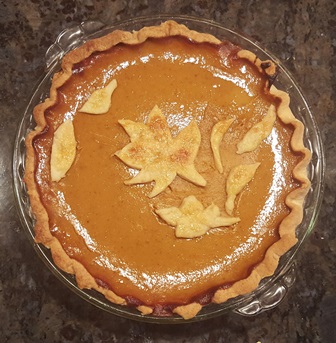
Our pumpkin pies feature leaves made from pate brisee dough, brushed with egg, and sprinkled with sugar before baking; they’re attached after the pie is baked.
Tonight, we’re going to eat leftovers with the addition of a simple winter salad–seeds from a ripe pomegranate, sections of a tangerine or two, slices of blood orange and a ripe pear tossed into some fresh greens along with small chunks of goat cheese and walnuts–drizzled with a toasted sesame dressing. And best of all, I can pluck most of the fruit walking around the farmette after I check on the plants, the bees, and the chickens. There’s work to do–plenty of it. But the way I see it, I’m honored to do work that blesses both the giver and the receiver.
* * *
Enjoy reading about farming topics? Check out my cozy mysteries–A BEELINE TO MURDER and also THE MURDER OF A QUEEN BEE (both in the Henny Penny Farmette series from Kensington Publishing).
These novels are chocked full of recipes, farming tips, chicken and beekeeping tips, sayings and, of course, a charming cozy mystery. For more info, click on the links under the pictures.
The books are available through online retailers such as Amazon, Barnes & Noble, Kobo Books, and Walmart as well as from traditional bookstores everywhere.
See, http://tinyurl.com/hxy3s8q
This debut novel launched the Henny Penny Farmette series of mysteries and sold out its first press run. It’s now available in mass market paperback and other formats.
See, http://tinyurl.com/h4kou4g
NEWLY RELEASED! This, the second cozy mystery in the Henny Penny Farmette series, is garnering great reviews from readers and industry publications.
Pomegranate Seeds–A Sweet Explosion on the Tongue
Strolling through our small orchard today, I cut into a pomegranate to check on the seeds–the edible part of the fruit. To my surprise, they had turned ripe. Inside, the seeds were gorgeous red jewels, plump and juicy. The sweet juice in the seeds carries a powerful antioxidant punch, too; it’s loaded with Vitamin C, Vitamin K, fiber, potassium, protein, and folate.
You might wonder about ways of cooking with pomegranate seeds. How about tossing them into citrus or a green salad, pairing them with goat cheese on a crostini, or sprinkling a few on poached pears dipped in chocolate, or incorporate them into a Mediterranean couscous with cashews or pistachios?
I think I’ll make some pomegranate jelly–it tastes great on toast, makes an excellent foil for goat cheese, and also creates a moist and delicious glaze for chicken.
The hardest part of making the jelly is separating the seeds from the white pith that holds the seeds in place inside the leathery peel.
The jelly recipe consists of few ingredients: pomegranate juice, sugar, water, and classic pectin. Here’s how I make the jelly.
POMEGRANATE JELLY RECIPE
Ingredients:
3 1/2 cups pomegranate juice (well strained to remove all the particles)
5 cups granulated sugar
6 tablespoons classic pectin
Directions:
Prepare boiling water canner and wash eight to ten half-pint jars in the dishwasher.
Place rings and lids in a pan of simmering hot water.
Cut one end of the pomegranate off to expose the membranes and seeds.
Section the pomegranate and scrape the seeds out into a medium to large bowl.
Repeat the process until you had several cups of seeds.
Rinse well and then run the seeds through a juice extractor.
Strain out the juice through a jelly bag or multiple layers of cheesecloth. Note: The juice stains, so take care to protect kitchen counters and clothing.
Put the juice and pectin into a large pot and bring to a boil, carefully stirring to blend in the pectin.
Add sugar and stir until completely dissolved and boil for one minute at a roiling boil that cannot be stirred down. Ladle off foam, if necessary.
Ladle jam into clean, hot jars leaving one-quarter inch head space. Attach hot lids and then the rings. Tighten to finger tight.
Lower the filled and sealed jars into the canner. Process for 10 minutes at a roiling boil. Remove and let cool.
* * *
If you enjoy reading about farmette topics (including gardening, beekeeping, and delicious recipes), check out my cozy mysteries A BEELINE TO MURDER and also THE MURDER OF A QUEEN BEE in the Henny Penny Farmette series (from Kensington Publishing).
These novels are available through online retailers such as Amazon, Barnes & Noble, Kobo Books, and Walmart as well as from traditional bookstores everywhere.
See, http://tinyurl.com/hxy3s8q
Now available in mass market paperback, this debut novel launched the Henny Penny Farmette series of mysteries and sold out its first press run.
See, http://tinyurl.com/h4kou4g
The second cozy mystery in the Henny Penny Farmette series, available Sept. 27, 2016, is now available on Net Galley (netgalley.com) for professionals and readers who write reviews. The book may be pre-ordered as well. Click on the link under the image.
The Figs Are Ripe, Fire Up the Grill
Last night the raccoons raided my fig trees, leaving a little deposit between honeybee apiary and the hen house. I know because this morning, I almost stepped in it . . . and I was barefoot and in still in my pajamas.
It was expecting the raccoons to drop by. It’s that time of the year when they like to show up for a little late night dining. Who can blame them. Figs ripened to perfection are among my favorite fresh foods, too.
Right now, the limbs of my Genoa White Fig hold an abundance of fruit covered in a thin green skin with rose-colored flesh. Whether you prefer to dry figs, make them into jam, use them in a tart, or serve them fresh with a little goat cheese, almost any variety of ripe fig will be delicious. They are an ancient food, dating back thousands of years to Asia Minor. The trees are hardy and can reach 12 to 20 feet tall.
The Brown Turkey, like the White Genoa, is self fertile and produces a multitude of delectable figs by its third year. The skin of Brown Turkey figs turns violet-brown with watermelon-colored flesh when fully ripe. Also, ripe figs turn downward from the limb–it’s how we they’re ready for picking.
I like to serve figs wrapped in Prosciutto, stuffed with a lovely, locally made goat cheese, and grilled. They make a great appetizer when friends drop by this time of year. The figs and goat cheese will pair nicely with a bottle of your favorite wine.
Since we live only about 25 to 30 minutes from the Napa wine country, we tend to buy local.
RECIPE: GRILLED FIGS, GOAT CHEESE, and PROSCIUTTO
Ingredients:
6 to 8 Brown Turkey or other ripe figs
1/3 cup goat cheese (or a bit more as needed; try herb goat cheese as a variation)
6-8 slices of Prosciutto
1/3 cup organic raw honey
Directions:
Fit a pastry bag with a tip to pipe the goat cheese.
Fill the bag with goat cheese.
Cut tiny openings into the bottom of each fig to permit insertion of the piping tip.
Pipe the filling into 8 to 10 figs (they’ll swell; don’t over fill or they’ll split).
Wrap slices of Prosciutto around each stuffed fig.
Brush the grill grate with olive oil.
Grill the figs 2 to 3 minutes.
Remove from heat, plate the figs, and drizzle honey across them.
Serves: 4 (2 figs per person)
Easy Orange Marmalade
Who can resist the flavors of homemade jams? Whether it embellishes an appetizer of grilled fig and melted goat cheese or is spread upon a fat slice of fresh-baked bread, jam has power to elevate any meal to another level.
Using the seedless oranges growing on our farmette trees, I’m making marmalade. Marmalade made with the oranges ripening this time of year make great additions to holiday gift baskets. I like to add jars of honey, fresh tangerines, nuts, summer jams, and homemade treats.
RECIPE FOR ORANGE MARMALADE
Ingredients:
4 large oranges (preferably a seedless variety)
2 medium lemons
1/2 teaspoon butter (to reduce foaming)
1/8 teaspoon baking soda
6 Tablespoons dry classic pectin
5 1/2 cups sugar
Directions for Preparing the Jars and Canner:
Wash pint jars in the dishwasher or wash the jars and screw rings in hot soapy water, rinse, and drain upside down on paper towels.
Remove the wire rack from the canner and set aside; then, fill the canner half full of water and bring to a simmer.
Directions for Making the Fruit Mixture:
Wash the oranges and lemons.
Peel the fruit, using a vegetable peeler or a sharp paring knife. Discard any seeds and the pithiest parts of the inner peeling as the pith tastes bitter.
Cut the peeled skins into narrow strips.
Pour water into a saucepan.
Add baking soda and strips of peel.
Bring to boil and then reduce the heat, simmering for 20 minutes and stirring as needed.
Cut the fruit into thin quarters.
Add the fruit and juice to the saucepan of simmering peelings, cover, and allow everything to simmer for 10 minutes.
Remove 4 cups of the fruit/peeling/juice mixture and pour into a large saucepan (6 or 8 quart) or stock pot.
Stir in the pectin and add the butter and sugar, mixing well.
Bring to a roiling boil, stirring constantly, for a full minute and then remove from heat, skimming off any foam.
How to Can the Marmalade:
Ladle the fruit mixture into the warm, clean jars, leaving between 1/4 and 1/8 inch space from the top.
Wipe the jar rims before placing the jars on the wire rack of the canner.
Lower the wire rack of jars into the simmering water in the canner.
Make sure the jars are covered by 2 inches of water (add boiling water if necessary).
Cover with lid and boil for 15 to 20 minutes.
Turn off flame, remove the jars of marmalade, and set them onto a towel to cool.
Listen for the popping sound that signals the lids have sealed. Check lids for seal once the jars have cooled by pushing against the center of the lid. If it springs, the jar has not sealed and must be refrigerated. The marmalade will still be good to eat.
Jam, Jelly, Conserve, & Fruit Butter
I admit to having a weakness for palate-pleasing soft spreads made from fresh fruit. My taste for fruit spreads started in my childhood with my grandmother, who introduced me to the process of picking and preserving the fresh seasonal fruits we found on the farm–mulberries, damson plum, blackberries, gooseberries, and peaches.
My grandmother would load the breakfast table with hearty farm-to-table foods and hot, freshly made biscuits that we slathered with butter. I could always count on at least a couple of bowls of jams or jellies. For us farmers, breakfast and lunch were the most important meals of the day, providing us with energy for the hours of toil that followed those meals.
Later, as an avid traveler, I fondly remember breakfasts in the United Kingdom and throughout Europe, especially France, where my petit déjeuner included strong coffee, juice, and bread (usually some type of roll such as brioche or croissant), butter, and an exquisite soft spread of jam, jelly, fruit butter, or conserve. You might wonder, what’s the difference?
Jam: made from fruit, sugar, and pectin (to thicken) that are boiled to achieve a spreadable consistency
Jelly: made from juice (from various ingredients or fruit that has been crushed and strained), sugar, pectin, and acid, gently boiled to render clear color and firm shape
Conserve: fruit and nut spreads that are chunky; they make a nice condiment for certain meat dishes and cheeses, like a goat cheese with fig-walnut conserve
Preserves: fruit in jelly
Fruit Butter: made from fruit that has been slow cooked until creamy and color is opaque or translucent
As I write this, I have four cases of organic ripe apricots and cherries on my kitchen counter from the farmer’s market. So, like my grandmother, I’m going to eat my breakfast and then work for the next several hours preserving these delicious seasonal fruits into spreads for future breakfasts.
 Facebook
Facebook Goodreads
Goodreads LinkedIn
LinkedIn Meera Lester
Meera Lester Twitter
Twitter





